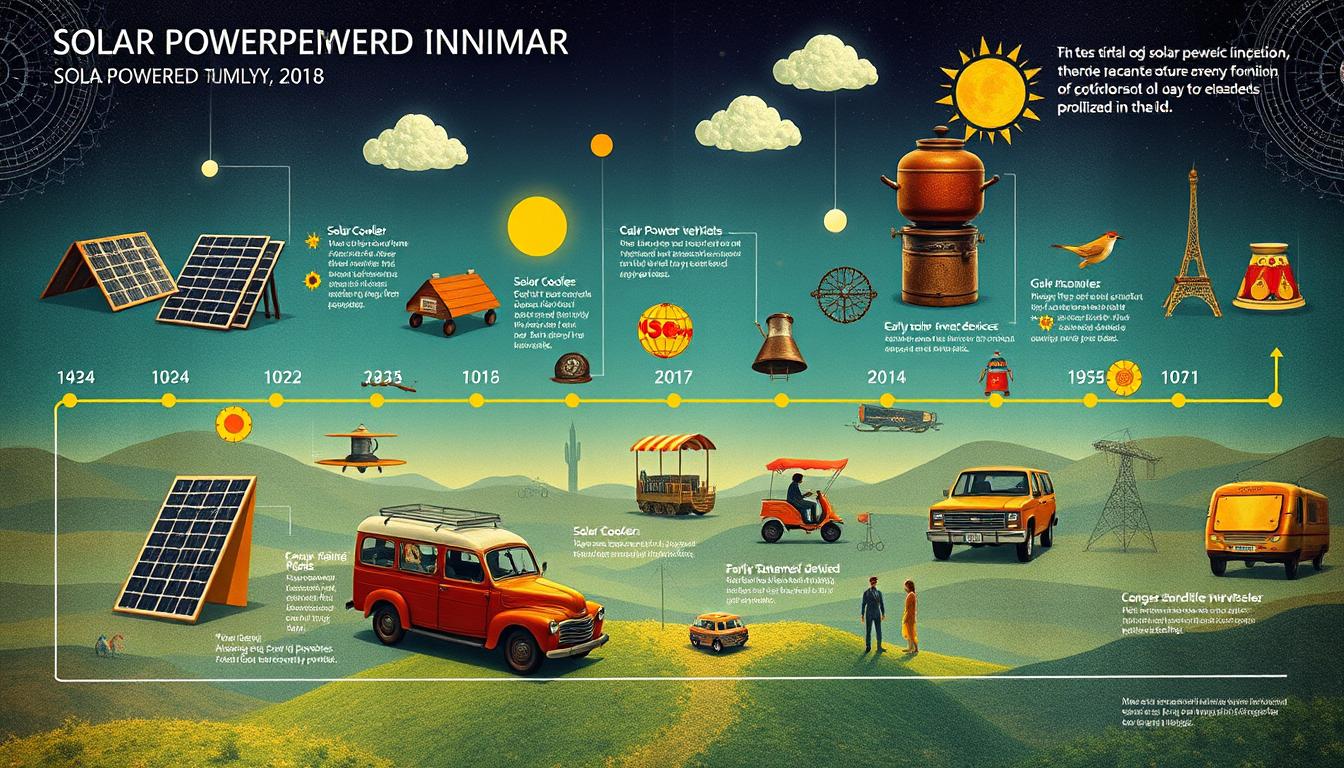Ever wondered how long we’ve used the sun’s power? I’ve explored the world of historic solar innovations. It’s a journey that changes how you see sunlight!
Solar energy has a long history, from ancient times to today. People used sunlight in clever ways long before electricity. These milestones are key to our clean energy future.
Looking into this history, I’m amazed by our ancestors’ smart ideas. Their work set the stage for today’s solar technology. It’s a story of creativity that spans the world and time, showing that great ideas can be as bright as the sun.
Key Takeaways
- Solar energy use dates back to ancient civilizations
- Early solar innovations included fire-starting and architecture
- Scientific discoveries in the 18th and 19th centuries propelled solar tech
- The photovoltaic effect was a game-changer for solar power
- Space exploration boosted practical solar cell development
- Energy crises spurred further solar innovation
- Modern solar tech blends efficiency with aesthetics
The Dawn of Solar Energy: Ancient Applications
I’m always amazed by how long humans have been harnessing the sun’s power. Our ancestors were really smart in using early solar technology. Let’s take a fun journey through time to explore these clever innovations!
Magnifying Glasses and Burning Mirrors
Imagine it’s the 7th century B.C., and someone’s starting a fire with a magnifying glass. That’s a cool trick! Greeks and Romans took it further, using burning mirrors in religious ceremonies. It must have been amazing to see priests seem to summon fire from the sun.
Sunrooms in Roman Architecture
Romans loved the sun. They built bathhouses with huge south-facing windows to soak up sunlight. It was like the first tanning salon! These designs kept Romans warm on cold days.
Anasazi Cliff Dwellings: Early Passive Solar Design
The Anasazi people in North America were solar energy pioneers. They built homes into south-facing cliffs. This design kept their homes warm in winter. They really knew how to work smarter, not harder.
These ancient solar applications show our ancestors were smart about using the sun’s energy. They used it for everything from starting fires to heating homes. It’s amazing to see how our solar-powered gadgets have such a long, fascinating history.
18th and 19th Century Solar Breakthroughs
I’m excited to explore the solar breakthroughs of the 18th and 19th centuries. This time period saw the start of modern solar technology.

In 1767, Swiss scientist Horace de Saussure created a solar collector. This device caught heat from the sun, starting solar thermal technology. It was like capturing sunshine in a bottle!
Then, in 1816, Robert Stirling patented the “economiser.” This invention helped shape solar thermal electric technology. It was a major breakthrough!
The biggest discovery came in 1839. Edmond Becquerel found the photovoltaic effect. This finding sparked the solar power movement we see today.
“The power of the sun is now at our fingertips, thanks to the brilliant minds of the past.”
In the 1860s, August Mouchet came up with solar-powered steam engines. This idea led to parabolic dish collectors. These devices focus sunlight like a cosmic magnifying glass.
These early solar inventions paved the way for our clean energy future. It’s incredible to see how far we’ve come, thanks to these pioneers from long ago!
The Photovoltaic Effect: A Game-Changing Discovery
Exploring solar cell history, I’m struck by a single discovery’s impact. The photovoltaic effect, found in the 19th century, is the base of today’s solar panels.
Edmond Becquerel’s Electrolytic Cell Experiment
In 1839, French physicist Edmond Becquerel made a key find. He was working with an electrolytic cell when he saw something odd. The cell made more electricity when light hit it. This was the start of the photovoltaic effect, but its true power was yet to be seen.
Selenium and the Birth of Photovoltaic Cells
In 1873, Willoughby Smith discovered selenium’s light sensitivity. This caught the attention of William Grylls Adams and Richard Evans Day. In 1876, they found selenium could make electricity when light hit it. This brought us closer to making solar cells work.
Charles Fritts and the First Solar Cells
In 1883, Charles Fritts made the first solar cells. He used selenium wafers and got 1-2% efficiency. Though small by today’s standards, it was a huge step forward. Fritts’ work started a new era in solar energy.
Looking back, I’m amazed by these pioneers. Their curiosity and creativity led to the solar tech we use today. It shows our drive for cleaner, renewable energy.
Early 20th Century: Laying the Groundwork for Modern Solar Technology
Exploring the early 20th century, I’m struck by the pioneering work in solar technology. This period was filled with innovations that paved the way for today’s solar panels.

In 1904, Wilhelm Hallwachs made a groundbreaking discovery. He found that copper and cuprous oxide react to light. This breakthrough opened new paths for solar research.
Just a year later, Albert Einstein changed the game with his paper on the photoelectric effect. His work not only won him a Nobel Prize in 1921 but also laid a key foundation for solar technology.
“If the rabble continues to occupy itself with you, then simply don’t read that hogwash, but rather leave it to the reptile for whom it has been fabricated.” – Albert Einstein
In 1918, Jan Czochralski invented a way to grow single-crystal silicon. This method, though small at first, became vital for making modern solar cells. It shows how a clear vision can lead to big changes.
| Year | Innovator | Contribution | Impact on Solar Technology |
|---|---|---|---|
| 1904 | Wilhelm Hallwachs | Discovered photosensitivity of copper and cuprous oxide | Expanded understanding of photosensitive materials |
| 1905 | Albert Einstein | Published paper on photoelectric effect | Provided theoretical foundation for photovoltaic technology |
| 1918 | Jan Czochralski | Developed method to grow single-crystal silicon | Enabled production of high-efficiency solar cells |
These early innovations set the stage for solar technology’s rapid growth. It’s amazing to think how these small steps led to our solar-powered future.
The 1950s: The Birth of Practical Solar Cells
I’m excited to share the groundbreaking developments in solar technology during the 1950s. This decade marked a pivotal moment in the history of renewable energy. Innovations from this time shaped the future of solar power.
Bell Labs and the Silicon Solar Cell
In 1954, a game-changing breakthrough happened at Bell Labs. Scientists Daryl Chapin, Calvin Fuller, and Gerald Pearson created the first practical silicon solar cell. This invention achieved an impressive 4% efficiency, later improved to 11%.
It was a quantum leap forward, paving the way for the commercialization of solar technology.
The silicon solar cell was a marvel of engineering. It converted sunlight directly into electricity, without the need for moving parts or complex machinery. This simplicity made it perfect for a wide range of applications.
From powering small devices to potentially supplying electricity to homes and businesses, it was versatile.
Space Race: Solar Cells in Satellites
Just four years later, in 1958, solar technology reached new heights – literally. The Vanguard I satellite launched into orbit, carrying a small solar array to power its radios. This marked the dawn of space solar technology, a field that would become crucial in the decades to come.
| Year | Milestone | Impact |
|---|---|---|
| 1954 | First practical silicon solar cell | Enabled commercial solar tech |
| 1958 | Solar cells in Vanguard I satellite | Pioneered space solar technology |
These advancements in silicon solar cells and space solar technology set the stage for a solar-powered future. The 1950s proved that solar energy was not just a dream, but a practical reality with immense potential.
In the past, what types of solar-powered inventions did people create?
I’ve always been fascinated by historic solar inventions. As I explore the solar-powered devices history, I’m amazed by our ancestors’ ingenuity. Let’s look at some groundbreaking solar inventions from the past.
Solar-Powered Engines and Steam Boats
In the 1860s, inventors like August Mouchet and Abel Pifre were pioneers. They created solar-powered engines and steam boats. This showed what was possible with sunlight.
Solar Water Heaters
Clarence Kemp patented the first commercial solar water heater in 1891. This was a big step in using solar energy for everyday needs.

Photovoltaic-Powered Devices
The 1950s brought early photovoltaic-powered devices. It’s amazing that inventors made solar-powered dollar bill changers and computer punch card decoders. These innovations helped start modern solar technology.
| Year | Invention | Inventor |
|---|---|---|
| 1860s | Solar-powered engines and steam boats | August Mouchet and Abel Pifre |
| 1891 | First commercial solar water heater | Clarence Kemp |
| 1950s | Photovoltaic-powered devices (e.g., dollar bill changers) | Various inventors |
| Late 1950s-1960s | Solar-powered satellites | Space agencies and researchers |
These historic solar inventions led to today’s advanced solar technologies. From simple beginnings to powering satellites, solar energy has made huge progress. I’m excited to see what the future holds!
The 1970s Energy Crisis: A Catalyst for Solar Innovation
I remember the 1970s as a key time for solar tech. The solar energy crisis was tough, but it sparked a big change in renewable energy. It’s amazing how a crisis can lead us to find new solutions.
In 1973, I was excited when the University of Delaware showed off “Solar One.” This building was a mix of solar thermal and photovoltaic tech. It showed us what was possible with determination.
The government also took notice. They passed the Solar Energy Research, Development and Demonstration Act in 1974. It was a big step towards using the sun for energy.
We’re not just looking to the stars anymore; we’re looking to the sun to power our future.
People like you and me started to get interested in solar panels too. It was a moment when everyone realized the sun could power our homes.
| Year | Solar Energy Milestone | Impact |
|---|---|---|
| 1973 | “Solar One” created | Demonstrated combined solar thermal and PV power |
| 1974 | Solar Energy Research Act passed | Increased government support for solar research |
| Late 1970s | Rise in residential solar interest | Sparked widespread public engagement in solar energy |
Looking back, it’s funny how a crisis led to such bright ideas. The 1970s solar crisis changed our energy policies and our thinking. We learned the sun’s power was real and could lead to a sustainable future.
Modern Advancements: Aesthetics Meets Efficiency
Solar tech has changed a lot. It used to be big and ugly, but now it’s sleek and powerful. It’s like adding a cool hat to your home that also works hard!
Building-Integrated Photovoltaics (BIPV)
BIPV is the new cool thing. It hides solar cells in building materials. Think of windows that turn sunlight into power for your TV. It’s smart and looks great!
Solar Roof Tiles and Shingles
Companies like Tesla are making solar roof tiles. They look like normal roofs but are actually solar panels. Your neighbors won’t even notice you’re using solar power!
Innovative Solar Panel Designs
Old solar panels are gone. Now, we have designs that look like art. You can get green energy and impress your friends at the next barbecue!
FAQ
What were some ancient solar applications?
What were some significant solar breakthroughs in the 18th and 19th centuries?
What was the significance of the discovery of the photovoltaic effect?
What were some early 20th century advancements in solar technology?
What were the major solar breakthroughs in the 1950s?
In the past, what types of solar-powered inventions did people create?
How did the 1970s energy crisis impact solar innovation?
What are some modern advancements in solar technology?
Source Links
- The History of Solar – https://www1.eere.energy.gov/solar/pdfs/solar_timeline.pdf
- Solar History: Timeline & Invention of Solar Panels – https://www.energysage.com/about-clean-energy/solar/the-history-and-invention-of-solar-panel-technology/
- A Brief History of Solar Panels – https://www.smithsonianmag.com/sponsored/brief-history-solar-panels-180972006/




Interesting read! But did the Romans really understand solar power, or was it just architectural design? Lets debate this, folks!
Interesting read, but werent magnifying glasses used for reading and not for solar purposes? Seems like a twist of historical facts to me.
Solar inventions, huh? But isnt it ironic how were still so dependent on fossil fuels? Do sunrooms even count as solar innovation? #JustThinkingOutLoud
Interesting read, but didnt the Greeks use solar power for heating, too? Why isnt that mentioned? Just a thought.
Crazy how Romans had sunrooms before electricity! Wonder if todays solar tech can make them even more efficient?
Imagine combining ancient Roman wisdom with modern solar tech. History meets future!